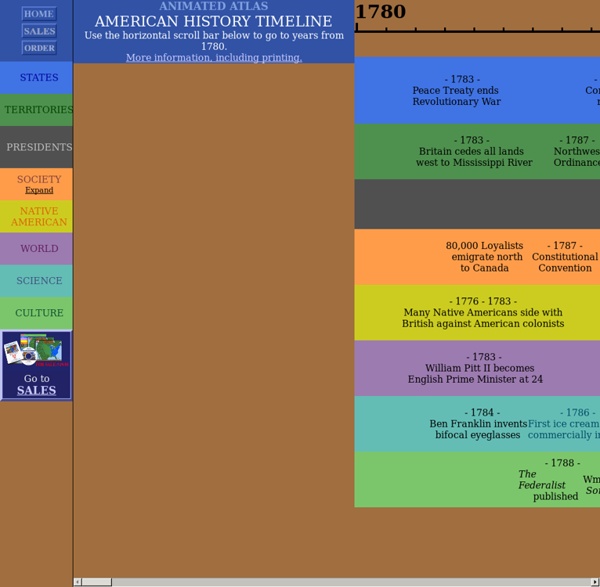



United States of America timeline A chronology of key events: 1565 - First permanent European settlement in North America - St Augustine, present-day Florida - founded by the Spanish. North America is already inhabited by several distinct groups of people, who go into decline following the arrival of settlers. 1607 - Jamestown, Virginia, founded by English settlers, who begin growing tobacco. 1620 - Plymouth Colony, near Cape Cod, is founded by the Pilgrim Fathers, whose example is followed by other English Puritans in New England. 17th-18th centuries - Hundreds of thousands of Africans brought over and sold into slavery to work on cotton and tobacco plantations. 1763 - Britain gains control of territory up to the Mississippi river following victory over France in Seven Years' War. War of Independence 1774 - Colonists form First Continental Congress as Britain closes down Boston harbour and deploys troops in Massachusetts. 1783 - Britain accepts loss of colonies by virtue of Treaty of Paris. Civil War Global assertiveness
“A Thousand Midnights”: Chicago and the Legacy of the Great Migration When I was growing up, my mother, Bette Parks Sacks, often told me stories about her youth in Mississippi. She spoke in a slow, sweet drawl, despite the fact that she’d spent her entire adult life in Chicago. I knew of the hardships and beauty of the South, transmitted to me through vivid recollections of her childhood and adolescence. I knew of her deep connection to the land, a holdover from a less-than-idyllic time when she picked cotton from sunup to sundown, beginning at the age of six. I knew that when she and her father headed to Chicago, in the nineteen-fifties, the day after she graduated from high school, they’d left everything behind, including almost all existing photographs of their large family. At the time, I didn’t realize that these intensely personal stories were part of a much larger historical narrative, one that was shared by millions of other black people who went on the same journey. “A Thousand Midnights,” a film from Brown Planet Productions, on Vimeo.
Archiving Early America Primary History - Famous People - Christopher Columbus Rate of Mass Shootings Has Tripled Since 2011, Harvard Research Shows Editor's note: The authors are scholars from the Harvard School of Public Health and Northeastern University; this article details their independent research, which is based on the mass shootings data Mother Jones has collected and published since 2012. In June, following gun attacks in California and Oregon, President Obama remarked that mass shootings are "becoming the norm." But some commentators claim that mass shootings are not on the rise. So which is it? Have mass shootings become more common? So why do we keep hearing in the media that mass shootings have not increased? Our method and how it works We used a Statistical Process Control method that analyzes the time interval between each incident. What our analysis reveals As the chart above shows, a public mass shooting occurred on average every 172 days since 1982. Because the chart signals that a new process started around September 2011, we can divide the chart at that point to analyze each phase separately.
Wikispace USI Students examine the historical and intellectual origins of the United States during the Revolutionary and Constitutional eras. They learn about the important political and economic factors that contributed to the outbreak of the Revolution as well as the consequences of the Revolution, including the writing and key ideas of the U.S. Constitution. Students also study the basic framework of American democracy and the basic concepts of America government such as popular sovereignty, federalism, separation of powers, and individual rights. Students study America’s westward expansion, the establishment of political parties, and economic and social change. Finally, students will learn about the growth of sectional conflict, how sectional conflict led to the Civil War, and the consequences of the Civil War, including Reconstruction. The Political and Intellectual Origins of the American Nation: the Revolution and the Constitution, 1763-1789 A. The Formation and Framework of American Democracy
Discovery of America *** Discovery of America Fact FileThe facts file is a chart containing fast, interesting information and list of the names of the explorers who played important roles in the discovery of America. Amerigo Vespucci arrives in the New World Discovery of America - The Naming and Origin of the NameAn important part in the history and Discovery of America was the facts behind the name. The man responsible for naming the land, and the origin of the name, was a German called Martin Waldseemuller. Martin Waldseemuller printed and sold 1000 copies of the map across Europe. The Discovery of America - The Geradus Mercator World Map The Discovery of America - Close-up view of Mercator's Map showing the names given
USA TODAY | BEHIND THE BLOODSHED: THE UNTOLD STORY OF AMERICA’S MASS KILLINGS History : The USA Buffalo Bill "In 1886, Buffalo Bill's Wild West Show played to over one million people in New York city. It was one of the most elaborate shows on earth: there were cowboys and Indians, sharp shooters including the famed Annie Oakley, hundreds of horses, buffalo, elk and donkeys, and more than two hundred cast members, all moving about in a sweeping western landscape of mountains and plains. Soon after the show's stunning success in New York, it would go on to dazzle crowds in London, Paris, Rome and Barcelona, cementing the legend of the Wild West in the minds of people around the globe. Behind the extravaganza was one man -- a meager plainsman turned international celebrity and frontier hero, whose meteoric rise to fame was made possible only by his genius, and his hucksterism. His name was William Cody,better known to the world as Buffalo Bill."